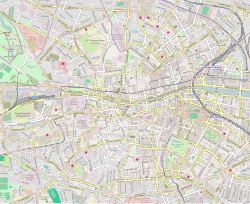53°20′33.25″N 6°16′17.54″W / 53.3425694°N 6.2715389°W
| St. Nicholas Within | |
|---|---|
 The church in 1786 | |
| Location | Nicholas St./Christ Church Place, Dublin |
| Country | Republic of Ireland |
| Denomination | Church of Ireland |
| Membership | 184 (in 1867) |
| History | |
| Former name(s) | St. Nicholas |
| Authorising papal bull | Pope Celestine's Bull of 1191 |
| Founder(s) | Bishop Donat |
| Dedication | Saint Nicholas of Myra |
| Dedicated | 11th century |
| Architecture | |
| Completed | Rebuilt 1707 |
| Closed | 1867 |
| Administration | |
| Parish | St. Nicholas Within |
St. Nicholas Within is a former Church of Ireland parish church in Dublin city, Ireland. It was located at the corner of Nicholas St. and Christchurch Place, where part of its entrance may be seen next to the Peace Park. The term may also refer to the civil parish in the barony of Dublin City which was one of nine and a half baronies in the old County Dublin.[1]
The church
editThe original church was built in the 11th century by Bishop Donat and was dedicated to Saint Nicholas of Myra, the patron saint of sailors. It received its name during the episcopate of Alexander de Bicknor (1317–1349), when the parish of St. Nicholas was extended outside the city so as to include the Manor of St. Sepulchre and the Deanery of St Patrick. The parish was divided into two parts: St. Nicholas Within the Walls and St. Nicholas Without.[2]
The church fell into disrepair in the 17th century, and was rebuilt in 1707. By 1835 it was again having problems, and it was unroofed, although a chapel in the church, St. Mary's, continued to be used until 1847. It was planned to demolish the church and build a new one. However, this was never done, and the parish united with that of St. Audoen in 1867.[2]
The parish
editThe parish is mentioned in Pope Celestine III's Bull of 1191, listing prebends.[3] The parish was the smallest parish in Dublin, measuring 5 acres (20,000 m2), 11 perches. At the time of its unification with St. Audoen's the population of the parish was 1,838, of which only 184 belonged to the established (i.e., Church of Ireland) church.[4] The parish corresponded to the civil parish of the same name.
The cemetery
editThe greater part of the graveyard was taken over by Dublin Corporation when building the Tholsel nearby. All that remained was a passage to the vaults. The names of those interred are available in the parish registers.[2]
- Nathaniel Catelyn, Speaker of the Irish House of Commons, was buried here in April 1637.
- Alexander Montgomery (1686–1729), soldier and politician from County Donegal, was buried here on 22 December 1729.[5]
- Sir Robert Doyne (1651-1733), former Chief Justice of the Irish Common Pleas, was buried here in 1733.
Chantry of St. Mary
editIn 1469, King Edward IV of England gave John Tiptoft, 1st Earl of Worcester permission to found a chantry in honour of God and the Blessed Virgin Mary and to have masses said for the benefit of the founders and all the departed. It was established in St. Nicholas Within in the chapel of St. Mary and was under the authority of the Provincial of the Augustinian Friars of England.
After the dissolution of the monasteries, chantries in parish churches in England were abolished, but no act was passed to abolish them in Ireland; some continued to function according to the use of the Church of Ireland. In this way, the chantry of St. Mary continued to function, as a sinecure, until 1882.[6]
Some years earlier the Parliament of Ireland had given Edward Somerton — justice of the Court of King's Bench (Ireland) — permission to found another chantry in St. Nicholas.
Notable parishioners
editDuring the Interregnum (1650s), Daniel Hutchinson, Thomas Hooke, John Preston and Richard Tighe, all served as alderman, were all Mayors of Dublin, and all worshipped at Dr Samuel Winter's independent congregation meeting at the Church of St. Nicholas Within. (Hooke like Hutchinson was an elder of the church.)[7]
Jonathan Edwards (1615–1681), from Denbighshire, Wales became curate at this church in 1661. He went on to become Archdeacon of Derry.[8]
See also
editNotes
edit- ^ Placenames Database of Ireland: St. Nicholas Within.
- ^ a b c Wright 1825, Churches.
- ^ Bernard 1903, pp. 8, 66.
- ^ Bennett 1992, p. 193.
- ^ Nichols 1853, p. 529.
- ^ Bennett 1992, p. 197.
- ^ Barnard 2000, pp. 81–83.
- ^ Reynell 1897, p. [page needed].
References
edit- Bernard, John Henry (1903), The cathedral church of Saint Patrick; a history & description of the building, with a short account of the deans, vol. 3, London: G. Bell, pp. 8, 66
- Barnard, Toby Christopher (2000), "Government of the boroughs:v. Dublin", Cromwellian Ireland: English Government and Reform in Ireland 1649–1660 (reprint ed.), Oxford University Press, pp. 77–89, ISBN 9780198208570
- Bennett, Douglas (1992), Encyclopedia of Dublin
- Nichols, John Gough, ed. (1853), "Parish Registers of St.Nicholas", The Topographer and Genealogist, vol. II, London: John Bowyer Nichols and Sons, pp. 520–521
- Reynell, William Alexander (October 1897), "The Estate of the Diocese of Derry: Part IX. Archdeacons of Derry", Ulster Journal of Archaeology, IV (1): 56–64, JSTOR 20563764
- Wright, George Newenham (1825), "Chapter 10: Churches", An Historical Guide to the City of Dublin, Illustrated by engravings, and a plan of the city (Second, with corrections and additional articles ed.), London: Baldwin, Cradock, and Joy, archived from the original on 31 October 2007, retrieved 2 November 2008
Further reading
edit- Craig, Maurice (1969), Dublin: 1660-1860, Dublin: Allen Figgis
- Gilbert, John (1854), A History of the City of Dublin, Oxford: Oxford University
